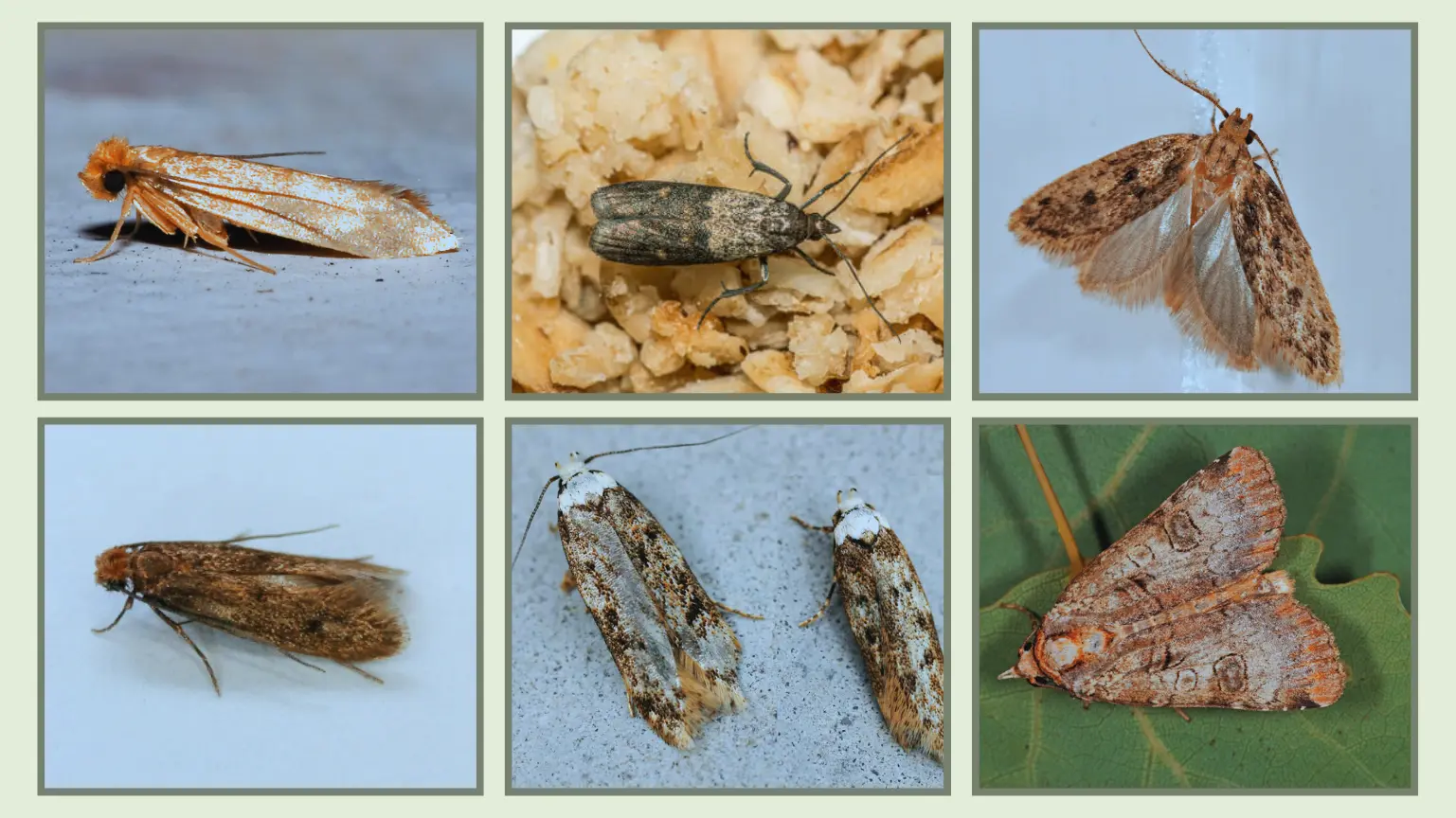Moths inside your home can be more than just a nuisance. Some chew holes in clothes, while others infest your pantry without you even noticing. Knowing which moth you’re dealing with helps you stop the damage early. In this guide, I’ll walk you through 7 common house moths, how to spot them, where they hide, and what keeps them active indoors—so you can protect your space and belongings.
1. Clothes Moth (Tineola bisselliella)
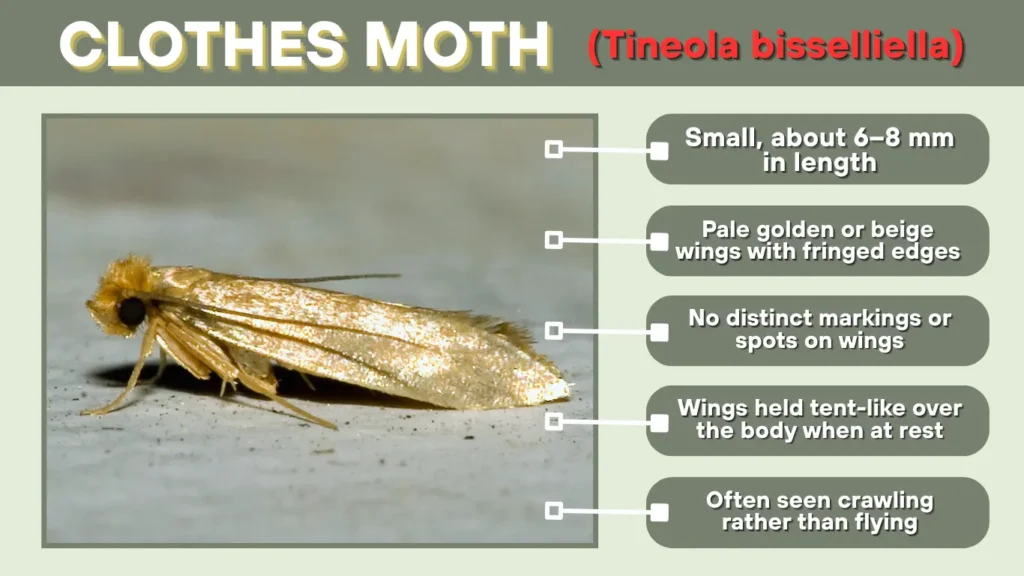
The clothes moth is one of the most common indoor moths, especially in homes where natural fabrics like wool, silk, or fur are stored. Unlike many moths attracted to lights, clothes moths prefer dark, undisturbed places such as closets and storage boxes. These moths are notorious for damaging household fabrics, making them a significant indoor pest.
Identification
- Small, about 6–8 mm in length
- Pale golden or beige wings with fringed edges
- No distinct markings or spots on wings
- Wings held tent-like over the body when at rest
- Often seen crawling rather than flying
Habitat
Clothes moths thrive in dark, undisturbed areas indoors. Common hiding and breeding spots include closets, wardrobes, storage boxes, and drawers, particularly where natural fibers are stored. They avoid light and prefer humid environments, making basements and attics ideal nesting areas.
Lifecycle
The lifecycle begins when the female lays eggs directly on fabric. These eggs hatch into larvae that feed on the fibers. The larval stage is the most destructive and can last from 1 to 3 months, depending on environmental conditions. Pupation occurs in silken cocoons, and adults emerge within a few weeks. Adults typically live for 2 to 4 weeks.
Activity
Clothes moths are most active indoors throughout the year, but infestations often increase during warmer months. They avoid bright areas and are rarely seen flying. Most activity occurs in dark spaces, particularly at night or in undisturbed storage areas.
Diet
The larvae, not the adults, are responsible for fabric damage. They feed on keratin found in natural fibers such as wool, silk, fur, and feathers. Items like sweaters, blankets, upholstered furniture, and even taxidermy are at risk. Adults do not feed and live only to reproduce.
2. Pantry Moth (Plodia interpunctella)

The pantry moth, also known as the Indianmeal moth, is a common indoor pest found in kitchens and food storage areas. Unlike fabric-feeding moths, this species infests dry food products, making it a serious nuisance in homes. It’s frequently introduced through contaminated groceries.
Identification
- Wingspan around 16–20 mm
- Forewings are reddish-brown on the outer half and grayish-white on the inner half
- Small and slender with a noticeable band where the two wing colors meet
- Often seen flying near pantry lights or walls
- Larvae are small, creamy-white caterpillars with brown heads
Habitat
Pantry moths are commonly found in kitchens, cupboards, and pantries. They lay eggs directly inside dry food packages such as grains, cereal, nuts, dried fruits, and pet food. Infestations usually start when eggs or larvae are brought home in store-bought goods.
Lifecycle
The female lays 100–400 eggs near or inside food sources. After hatching, larvae feed for 2–3 weeks before pupating in nearby cracks, crevices, or packaging folds. Adults emerge after 1–2 weeks and live for 5 to 25 days. The entire lifecycle may complete in about 4–6 weeks under warm indoor conditions.
Activity
Pantry moths are active year-round indoors, with population growth peaking in warmer months. Adults are usually seen fluttering around ceilings or lights, but the infestation often goes unnoticed until larvae are found in food or packaging.
Diet
Larvae feed on a wide variety of stored dry foods, including flour, rice, cereal, nuts, chocolate, powdered milk, dried fruit, and birdseed. Contaminated food is often covered in silk webbing and frass, making it unfit for consumption.
3. Brown House Moth (Hofmannophila pseudospretella)
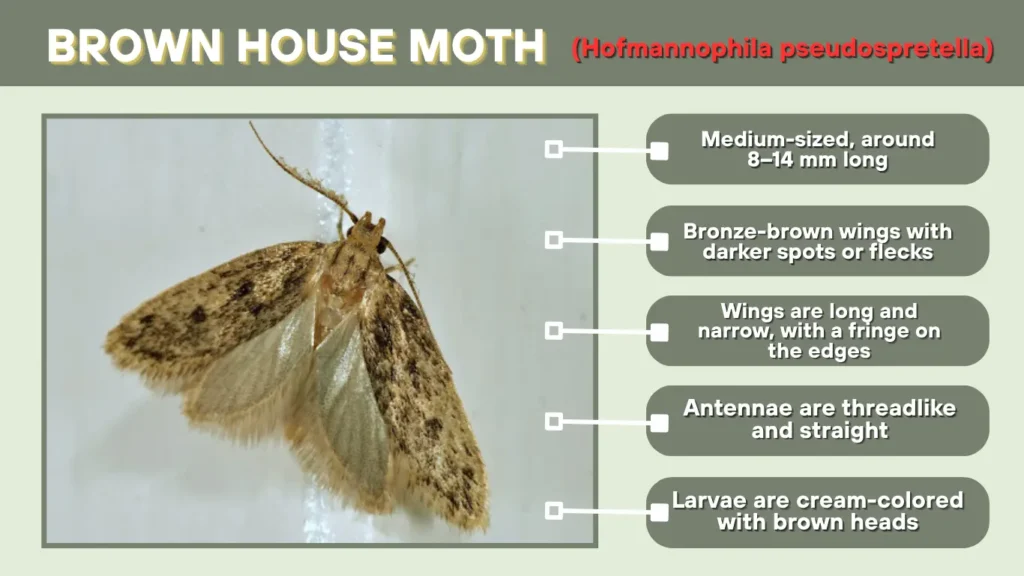
The brown house moth is one of the most widespread house moths, often found in domestic environments across the globe. It is associated with damp, poorly ventilated areas and can be a persistent pest in homes, feeding on both food and fabric materials.
Identification
- Medium-sized, around 8–14 mm long
- Bronze-brown wings with darker spots or flecks
- Wings are long and narrow, with a fringe on the edges
- Antennae are threadlike and straight
- Larvae are cream-colored with brown heads
Habitat
Brown house moths prefer dark and humid areas inside homes. Common habitats include basements, kitchens, utility rooms, and areas with poor airflow. They are often found in places where both food waste and organic materials are available, such as under furniture, in cracks, or inside storage boxes.
Lifecycle
Females lay up to 600 eggs on suitable materials. Eggs hatch into larvae that feed for several weeks, depending on humidity and temperature. Pupation usually occurs in hidden corners or within food or fabric material. Adults emerge and live for up to 2–4 weeks. Multiple generations may occur annually indoors.
Activity
They are active year-round in warm homes but are more commonly seen during late summer. Adults are drawn to indoor lights during the night but are typically more discreet than other moths. Larvae are often unnoticed until damage appears in stored items.
Diet
Larvae feed on a mix of food debris, animal fibers (wool, feathers), paper, leather, and even cereals or grains. This broad diet makes them adaptable to various indoor environments, particularly where cleanliness is compromised or clutter is present.
4. Case-Bearing Clothes Moth (Tinea pellionella)
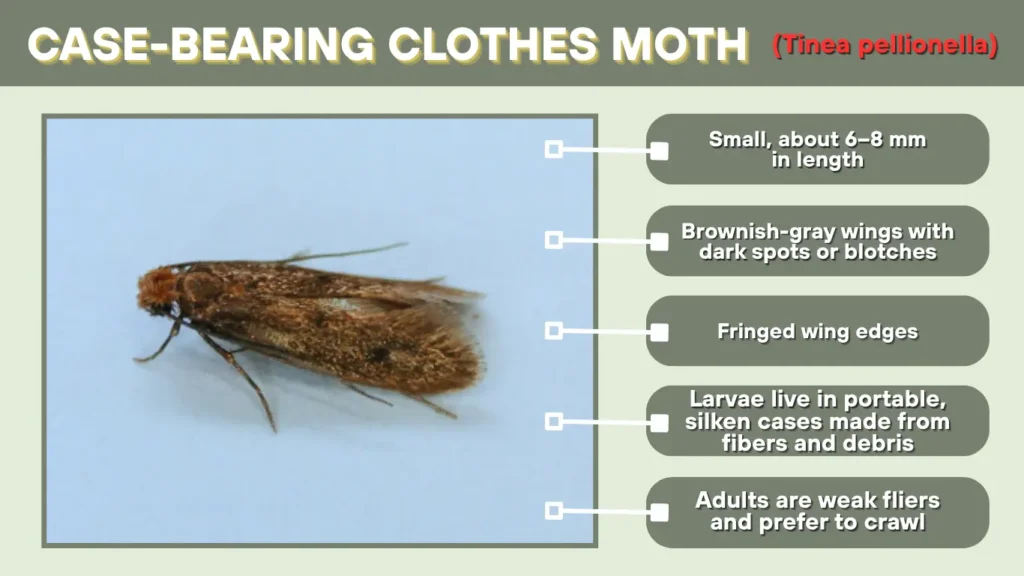
The case-bearing clothes moth is another fabric-damaging species commonly found indoors. It is similar in behavior to the common clothes moth but can be distinguished by its unique larval case. This moth is particularly destructive to household items made of natural fibers.
Identification
- Small, about 6–8 mm in length
- Brownish-gray wings with dark spots or blotches
- Fringed wing edges
- Larvae live in portable, silken cases made from fibers and debris
- Adults are weak fliers and prefer to crawl
Habitat
These moths seek quiet, dark places inside the home where natural fibers are undisturbed. They commonly infest closets, drawers, under furniture, and storage containers. Their presence is often hidden until damage is noticed on wool, feathers, or fur-lined clothing.
Lifecycle
The female lays eggs on suitable fabric. Once hatched, larvae immediately construct a protective case from nearby materials and carry it while feeding. The larval stage can last from several weeks to months. Pupation occurs inside the case. Adults emerge and live only to mate, with no feeding behavior.
Activity
They are active indoors throughout the year, with infestations often unnoticed due to the small size and secretive nature of the larvae. Case movement is subtle, and adults are rarely seen in the open. Activity may spike in warmer months in unventilated areas.
Diet
The larvae feed exclusively on animal-based fibers such as wool, silk, feathers, leather, and hair. They avoid synthetic fabrics unless blended with natural materials. Damage often appears as irregular holes or threadbare spots on garments, rugs, or upholstery.
5. White-Shouldered House Moth (Endrosis sarcitrella)
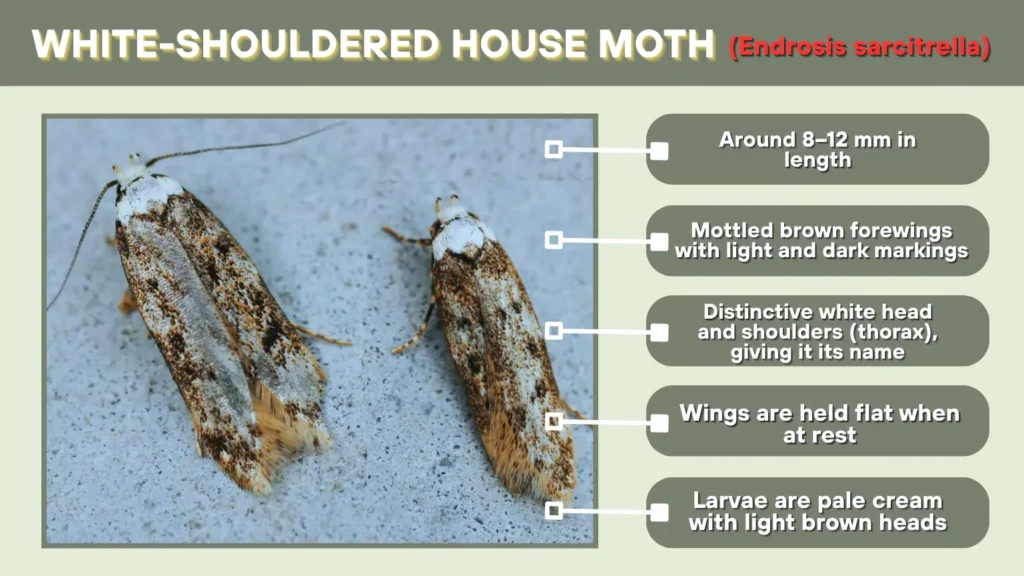
The white-shouldered house moth is a frequent indoor pest known for infesting stored food and household debris. While less destructive to clothing than clothes moths, its presence indicates poor sanitation or food storage issues in the home.
Identification
- Around 8–12 mm in length
- Mottled brown forewings with light and dark markings
- Distinctive white head and shoulders (thorax), giving it its name
- Wings are held flat when at rest
- Larvae are pale cream with light brown heads
Habitat
This moth thrives in warm, moist environments indoors. Common habitats include kitchens, pantries, basements, and storerooms. It may also inhabit bird nests in roof spaces or near vents, contributing to recurring indoor infestations.
Lifecycle
Females lay eggs on food residues or organic waste. Larvae feed for 1–3 months before pupating in hidden crevices or wall corners. The adult moth emerges in 1–2 weeks. Indoors, the life cycle can be continuous, with overlapping generations throughout the year.
Activity
White-shouldered house moths are active all year in heated homes. They are often seen flying at night near lights or resting on walls during the day. Their flight is erratic and short-distance, and infestations tend to be chronic if not addressed early.
Diet
Larvae are scavengers that feed on a wide range of organic material, including dry food waste, grains, flour, cereals, dried plants, pet food, and even dead insects. They may also chew through paper or cardboard packaging, contaminating stored items.
6. Miller Moth (Adult Army Cutworm)
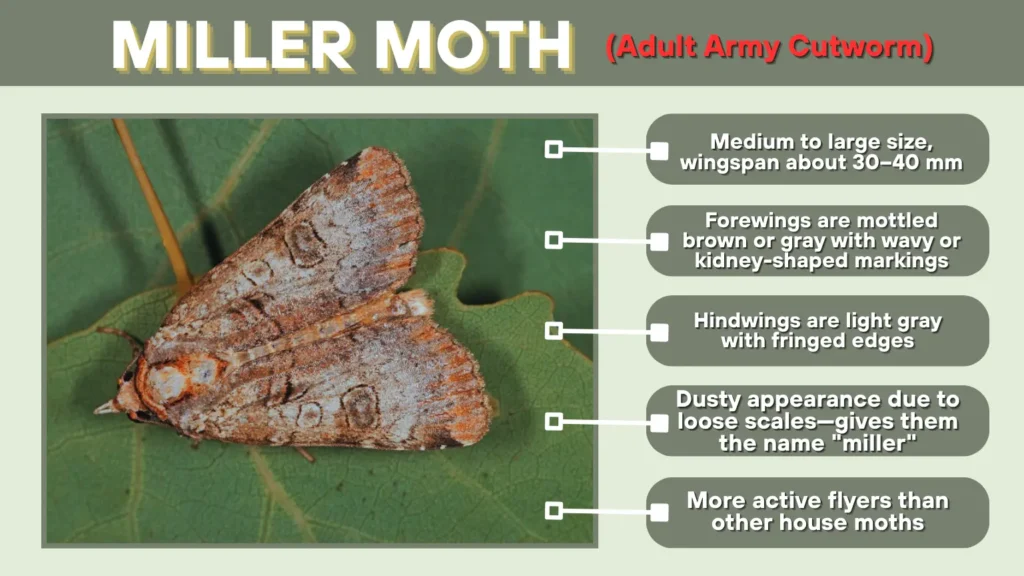
The miller moth is the adult stage of the army cutworm and is commonly seen entering homes during seasonal migrations. While they don’t cause damage indoors like pantry or clothes moths, their presence in large numbers can be a nuisance in residential areas.
Identification
- Medium to large size, wingspan about 30–40 mm
- Forewings are mottled brown or gray with wavy or kidney-shaped markings
- Hindwings are light gray with fringed edges
- Dusty appearance due to loose scales—gives them the name “miller”
- More active flyers than other house moths
Habitat
Miller moths typically live outdoors but seek shelter in homes, garages, sheds, and attics during their migration season—especially in dry regions. They are attracted to light and may hide behind curtains, under furniture, or inside closets during the day.
Lifecycle
The army cutworm overwinters as a caterpillar and pupates in early spring. Adult moths (miller moths) emerge and begin migrating in large numbers. They do not reproduce indoors. After migration, they return to the mountains or cooler areas to lay eggs in soil.
Activity
Miller moths are active primarily in late spring and early summer. Their activity peaks during the evening and night when they are drawn to indoor lights. Once indoors, they flutter around and hide in dark corners during the day, becoming a seasonal annoyance.
Diet
Unlike larvae, adult miller moths do not feed on household items. They primarily consume nectar and water outdoors. Indoors, they pose no threat to fabrics or food and are considered harmless aside from being a temporary nuisance.
7. Plaster Bagworm (Phereoeca uterella)
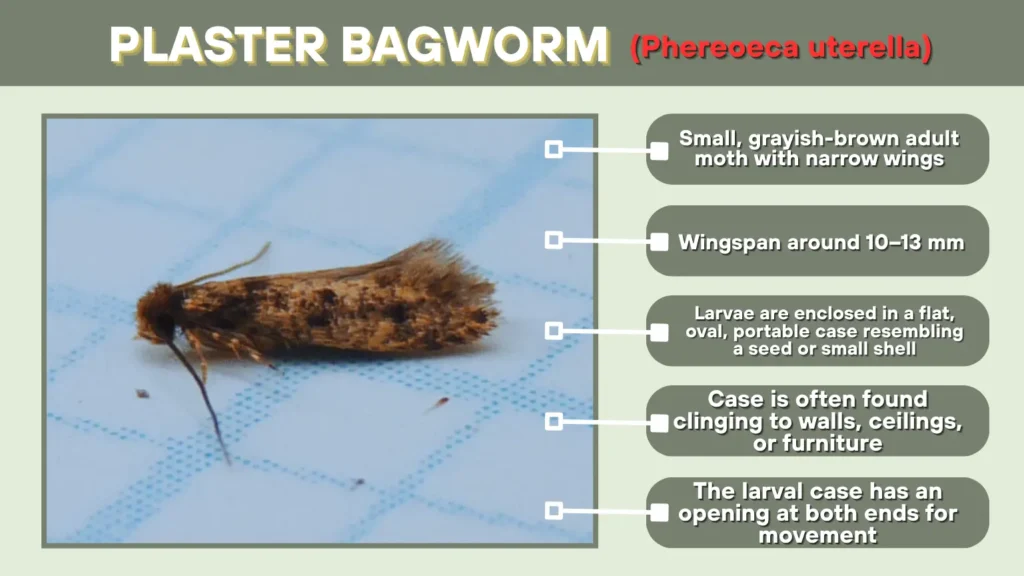
The plaster bagworm is a close relative of the clothes moth and is often found in homes, particularly in humid regions. It gets its name from the small, case-like structure it carries and builds from silk, dust, hair, and other household debris. Though less destructive, it’s still an indicator of indoor moth activity.
Identification
- Small, grayish-brown adult moth with narrow wings
- Wingspan around 10–13 mm
- Larvae are enclosed in a flat, oval, portable case resembling a seed or small shell
- Case is often found clinging to walls, ceilings, or furniture
- The larval case has an opening at both ends for movement
Habitat
Plaster bagworms prefer humid, undisturbed indoor areas. Commonly found on walls, ceilings, behind furniture, and near baseboards—especially in garages, closets, and laundry rooms. They avoid bright, busy spaces and thrive in areas with dust and organic debris.
Lifecycle
Eggs are laid on surfaces like walls or behind furniture. Upon hatching, the larvae build and carry their protective bag made of silk and fibers. They feed and grow inside this case over several months. Pupation also occurs within the bag. Adults live briefly, long enough to mate and lay eggs.
Activity
They are active year-round in warm, humid indoor environments. Larval cases are usually seen crawling slowly along vertical surfaces. Adults are rarely noticed and are not strong fliers. Their presence often becomes obvious when several larval cases accumulate.
Diet
Larvae feed on spider webs, wool, hair, dead insects, and organic debris. They do not feed on synthetic materials but can still be a nuisance if left unchecked. Clean indoor environments with reduced humidity help control infestations.
FAQs
1. What attracts moths to my house?
Moths are usually attracted to homes by food sources (like grains or flour), natural fabrics (like wool or silk), and dark, undisturbed areas. Lights at night can also draw flying adult moths indoors.
2. Are house moths dangerous to humans?
House moths don’t bite or sting, and they aren’t harmful to your health. However, their larvae can damage clothes, furniture, and stored food, making them a costly indoor pest.
3. How do I know if I have a moth infestation?
Signs include holes in clothing, webbing in dry food containers, or small moths flying around lights. Finding larvae or silken cases near storage areas or on walls is also a clear warning.
4. What’s the difference between clothes moths and pantry moths?
Clothes moths feed on fabrics like wool and are found in closets. Pantry moths infest dry foods and are often seen in kitchens or pantries. Their appearance and behavior differ significantly.
5. How can I get rid of moths in the house?
Clean and vacuum storage areas regularly, seal food properly, and store clothes in airtight containers. You can also use pheromone traps or natural repellents like cedar to help prevent infestations.

